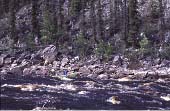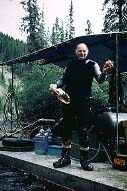You are hereThe Fortymile River: Wilderness Gold
The Fortymile River: Wilderness Gold
The thrumming sound of a generator filled the otherwise wild valley with the presence of man. As our three canoes drifted lazily around another bend, the noise ceased. For a few moments, we were again alone on the river. Alone with the falcon circling above, catching rising thermals off the cliff wall ahead. Alone with three fuzzy ducklings, scurrying after their mother to safety underneath a cottonwood stand. Alone with the river, steadily drawing us toward our ultimate destination, still another five days away.
 The water accelerated as it rounded the bend, piling up against the cliff wall. My mother, in the bow of our canoe, paddled forward as I swept us around into a ferry, cutting the inside of the corner. As we cleared the overhanging willows, the source of the earlier noise came into view: a bus-length platform on two aluminum pontoons. A tall man covered head to toe in neoprene stood on the bow of the platform wringing out his gloves. A woman in a purple t-shirt was shaking a black doormat into a large plastic pan. "Hey, come on over and see some gold!" she hollered, seeing us.
The water accelerated as it rounded the bend, piling up against the cliff wall. My mother, in the bow of our canoe, paddled forward as I swept us around into a ferry, cutting the inside of the corner. As we cleared the overhanging willows, the source of the earlier noise came into view: a bus-length platform on two aluminum pontoons. A tall man covered head to toe in neoprene stood on the bow of the platform wringing out his gloves. A woman in a purple t-shirt was shaking a black doormat into a large plastic pan. "Hey, come on over and see some gold!" she hollered, seeing us.
We had drifted into another era. If we had floated this river a hundred years ago, the miners would be using different tools, but their attitude, and the river, would remain the same. If anything, there would be more of them.
It was history, controversy, and road accessibility that had drawn me to the Fortymile River in eastern Alaska. On the eve of the Klondike gold rush, the Fortymile was the most populated gold field in the region. Howard Franklin first discovered gold on the river in 1886, and the town of Fortymile at the mouth quickly surpassed Fort Reliance (forty miles up the Yukon) as the main trading post of the interior, reaching a peak population of over a thousand. Ever since, prospectors have scoured the river bed and the benches alongside, extracting enough gold to make a living, but rarely a fortune.
In 1980, Congress added the 392 miles of the Fortymile river and its tributaries to the National Wild and Scenic river system. The advocacy group American Rivers has twice listed the Fortymile on its annual list of threatened rivers, saying that mining is incompatible with the wild nature of the river. Naturally, the miners who live here feel persecuted and threatened themselves.
There are only a handful of Alaskan river trips that have road access. The Taylor Highway travels right through the Fortymile basin, crossing two tiny tributaries before reaching the South Fork. Farther north, it crosses the river's main stem at the Fortymile Bridge. Eventually, the highway ends at Eagle, 55 miles down the Yukon from the mouth of the Fortymile. There are five put-ins and four take-out points accessible by road, allowing for trips ranging from 10 to 160 miles. One June morning, my 54-year-old mother and I, and Mike, Judy, Tony and Kate, friends from Anchorage, launched from the South Fork bridge for a 150-mile, seven day float.We saw most of the miners the first two days. The town of Chicken, with a summer population of around 200, is the base for most of the mining, and the only town in the whole drainage. Individuals and families work their claimed stretch of river with suction dredges, oversized vacuum cleaners that suck up the gravel on the bottom and send it tumbling down a sluice so that the gold drops out. That means somebody needs to don a wet suit and guide the hose along the bottom, breathing air pumped down from a compressor on the dredge.
Right from the beginning, it was the wilderness that dominated our attention, not the miners. It was hard to believe that the entire river has been mined, that the miners are all covering the river for a second time, scraping up the scraps left over from the crude bucket dredges and hand-dug holes of earlier generations of miners. The river seemed untouched. It was hours of floating between dredges, and later, days. Hills that would be called mountains in other states loomed a thousand feet over both sides of the river, forested with birch and spruce. The first two days of our trip, the river was gentle, smooth class I water winding gently through the country, with the occasional class II riffle around some bends.
We spent the first night at the abandoned gold town of Franklin. Cabins from sixty, seventy years ago were decaying handsomely, moss attacking the logs, while grass and wildflowers took over the roofs. Bits of iron machinery littered the fields, obscured from view until you nearly tripped over them: old gears, mulching cylinders with bars splaying out in different directions, long towing rods that looked like twenty-foot safety pins. Seventy years ago, Franklin had a post office, a school, and certainly a few bars.
Camped up the creek about a half mile were two retired couples, panning for gold. Tony, our trip biologist, found some diggings that looked like bear sign in the town, but one of the women told us, "Oh, it's probably Pat Scofield. He was up here the other day getting some good soil to grow tomatoes." The vastness of the country brought out the friendliness of everyone we met. It seemed that everybody was eager to talk, to trade stories, to tell us about their lives and what brought them to this beautiful river.
It was the next day that we met Pat and Eva Scofield. Eva, in her purple t-shirt, showed us a half-full vial the size of my little finger, containing the fruit of their last two weeks of labor. Pat pulled out three small nuggets, which he would turn into jewelry over the winter.
 The Fortymile River grew as we descended, tributaries flowing into it around every other bend. Later that afternoon, we reached the confluence of the South and the Middle forks, and suddenly the river doubled in size. The rapids grew more frequent and larger, and on the third day, we reached our first class III: the Falls rapid.
The Fortymile River grew as we descended, tributaries flowing into it around every other bend. Later that afternoon, we reached the confluence of the South and the Middle forks, and suddenly the river doubled in size. The rapids grew more frequent and larger, and on the third day, we reached our first class III: the Falls rapid.
A train of two foot waves shot our canoes straight across to a rock on the left bank, where half the current broke into a giant eddy, and the other half dropped into another train of three to four foot waves. Bouncing through the waves in our white-water canoe, narrowly missing the jagged pinnacle in the middle of the second wave train, I had a flash of what it must have been like for miners a hundred years ago, bobbing down the rapids in their hand built dories. They were miners, not boat builders, and more than one miner lost his supplies as his vessel disintegrated in rapids like this one.
 We were better prepared and instead of terror, we felt exhilaration. We almost portaged to run it a second time.
We were better prepared and instead of terror, we felt exhilaration. We almost portaged to run it a second time.
Below the rapid we passed the Fortymile bridge, the last take-out before entering Canada. For the next two days, we saw almost nobody. The solitude became complete, and class II rapids regularly punctuated hours of drifting. The peacefulness of drifting a wild river makes for a boring story, but provides spiritual rejuvenation from the demands of civilization.
We reached the final obstacle, the Canyon rapids, which at extremely high water can become unrunable. A giant hole appears on the right, and the lining trail disappears underneath raging river. During times of high water, you don't go down the lower river, because even the portage becomes nearly impossible.
When we reached it, the water level was perfect, and we shot through unscathed. Below the rapids the current slowed and the river widened. For the first time in the whole trip, we paddled to get somewhere, kneeling on the evening glass that was the river. We came around the last bend of the Fortymile to see a murky expanse of big, open, fast moving water: the Yukon.
At the 7 mile-per-hour trot of the Yukon, the remaining 55 miles of our trip to the town of Eagle was a too-quick day and a half. The late afternoon breeze kept pushing us out of the current, shoving us into slow water along the banks. This was too much work, we all agreed, so we stopped at an island, made an early dinner, and took a nap. Around nine o'clock in the evening, the wind died and we got back on the river.
 Rafting together, we drifted down the mighty river telling stories, playing twenty questions. The sun disappeared behind the hills to the north around eleven and the moon rose. The river was silent, peaceful as we drifted through the night, finally stopping around 2:00 a.m. at the last island in Canada.
Rafting together, we drifted down the mighty river telling stories, playing twenty questions. The sun disappeared behind the hills to the north around eleven and the moon rose. The river was silent, peaceful as we drifted through the night, finally stopping around 2:00 a.m. at the last island in Canada.
As we floated the last two hours into town on our last morning, we talked about the wonders of the trip. There are many wild rivers in Alaska, but we all felt that the friendliness of the miners we had met, people who genuinely loved the river and longed to share it with anyone who cared enough to float it, had made the trip. But the highlight, for Kate, came that second day, when we stopped at the Scofields' dredge. As we departed, Kate pulled a fresh tomato from her food sack and gave it to Pat. "Hold on a second!," he hollered, as they pushed off into the river. He went back to his box of gold, pulled out the largest nugget of their collection, and gave it to her. Only on the Fortymile is fresh produce still worth gold.
